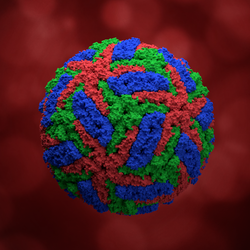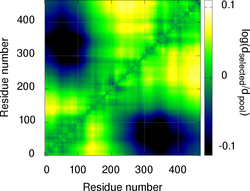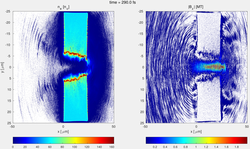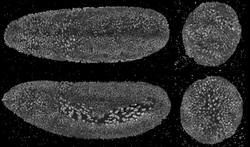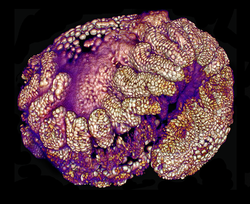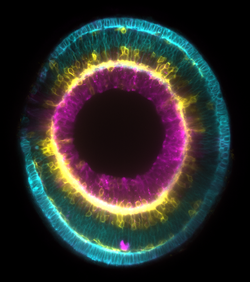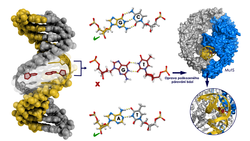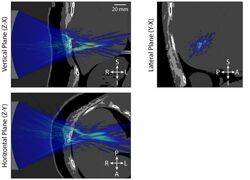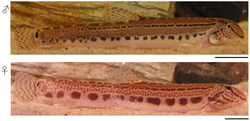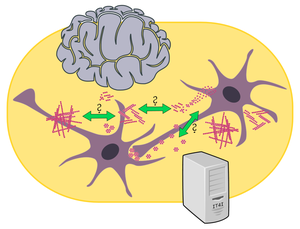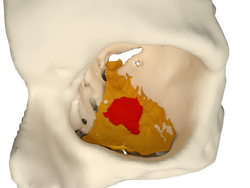All-Atom Any-Modality Molecular Diffusion Model for Biomolecule Design
Call: 34th Open Access Grant Competition; OPEN-34-1
Researcher: Anton Bushuiev
Institution: Czech Technical University in Prague, CIIRC
Field: Biosciences
Researchers at CIIRC CTU will harness the power of one of Europe’s most powerful supercomputers, LUMI, to develop artificial intelligence that assists in the design of new medicines. This advanced model learns from three-dimensional images of molecules how they interact – or, conversely, compete – with one another. Using these insights, it can propose new compounds that precisely target molecules associated with diseases such as viral infections or cancer. Scientists will then test these designs in the laboratory to verify their effectiveness. The resulting tool will also be made available to the wider scientific and medical communities.
This research is part of the CLARA Centre of Excellence, funded by the Johannes Amos Comenius Programme.
Generative models for bone dataset augmentation
Call: 34th Open Access Grant Competition; OPEN-34-72
Researcher: Martin Špetlík
Institution: Technical University of Liberec
Field: Biosciences
A research team from the Technical University of Liberec is using the LUMI supercomputer to create an extended dataset of clinical CT bone scans through generative machine learning models. The aim is to gain a deeper understanding of how differences in bone shape and structure between individuals relate to bone remodelling – a process essential for healthy bone function.
The scientists are investigating whether CT scans can reveal the degree of mechanical loading experienced by patients’ bones. Such insights could pave the way for more precise and individually targeted treatment of osteoporosis. To address the shortage of available clinical data, they are generating realistic synthetic CT scans using advanced generative neural networks.
The findings could contribute to earlier diagnosis, more effective treatment and fracture prevention, thereby reducing both the health and economic burden of an ageing population.
This research is part of the Czech Science Foundation project GA ČR 24-10862S – Data-driven modelling of bone morphology and mineral density.
Ribosomal tunnels
Call: 33rd Open Access Grant Competition; OPEN-33-14
Researcher: Michal Kolář
Institution: University of Chemistry and Technology Prague
Field: Biosciences
The image shows a cross-section of a bacterial ribosome, with the large subunit in shades of grey and the small subunit in shades of yellow. The nascent protein is dynamically displayed in blue and red on the right side inside the ribosomal tunnel.
Ribosomes are key molecular factories in cells – they produce essential proteins for life. The nascent protein chain passes through a tunnel inside the ribosome that is approximately 10 nm long. Although the mechanism of protein synthesis is the same in all organisms, ribosome tunnels can vary considerably. The shape and chemical composition of the tunnel walls influence, for example, the speed and accuracy with which proteins are synthesised. Michal Kolář and his team from the University of Chemistry and Technology in Prague use the Karolina and LUMI supercomputers for atomistic simulations to observe how proteins move inside the ribosomal tunnel. This provides detailed information about a complicated process to study experimentally. The results of the simulations allow them to understand better how ribosomes are regulated and their evolutionary history. This directly impacts the development of antibiotics and drugs for neurodegenerative diseases, in which the ribosome, its tunnel, and nascent proteins play a key role.
This research is also supported by the Czech Science Foundation (project Towards an atomic understanding of the first moments in the life of protein, 23-05557S).
Artificial intelligence and the search for new drugs to treat pain and prostate cancer
Call: 33rd Open Access Grant Competition; OPEN-33-54
Principal Investigator: Rafael Doležal
Institution: 2nd Faculty of Medicine, Charles University
Field: Biosciences
The figure illustrates the basic principle of virtual screening of new TRMP8 receptor antagonists using molecular docking and deep neural networks (AI & GPU).
Rafael Doležal from Charles University uses artificial intelligence (AI) and supercomputers, specifically Karolina and LUMI, to streamline drug design. In this project, he focuses on identifying new antagonists for the TRPM8 receptor, which is associated with the perception of cold and diseases such as migraine, steatohepatitis, and prostate cancer. In his research, he intends to use AI for ultra-fast screening of up to 1 billion chemical compounds to find suitable candidates for new drugs. This process combines molecular docking with machine learning, allowing symbolic representations of chemical molecules to be evaluated extremely quickly. The goal is to design new drug candidates for certain types of neuropathic pain and cancer using advanced AI technologies, which will be verified experimentally in in vitro tests.
Advancing Risk Stratification and Treatment in Multiple Myeloma Through Genomic Analysis of Circulating Tumor Cells
Call: 32nd Open Access Grant Competition, OPEN-32-9
Primary Investigator: David Žihala
Institution: University of Ostrava
Research Area: Biosciences
The Karolina supercomputer helps scientists from the University of Ostrava to study circulating tumor cells (CTCs) in patients with multiple myeloma, the second most common blood cancer. CTCs can escape the bone marrow and enter the bloodstream. The amount of CTCs in the blood serves as an important indicator of disease prognosis. In this project, led by David Žihala, researchers will analyse data from patients with different levels of CTCs. The aim is to understand the biology of these cells and their role in disease progression. They will also test the possibility of using whole genome sequencing of CTCs from peripheral blood (blood that circulates in blood vessels) to more accurately estimate the risk of disease development or progression. This minimally invasive diagnostic approach could improve the diagnosis and treatment of patients with multiple myeloma in the future. This research is funded by the European Union under the SALVAGE (Operational program Johannes Amos Comenius) and LERCO (Operational Programme Just Transition) projects.
Graphene-based materials in nanomedicine
Call: 32nd Open Access Grant Competition, OPEN-32-24
Primary Investigator: Markéta Paloncýová
Institution: CATRIN, Palacký University Olomouc
Research Area: Biosciences
The Karolina and LUMI supercomputers are helping CATRIN scientists investigate how graphene materials interact with biomembranes using molecular dynamics simulations. Graphene derivatives have been studied in recent years for their prospects in nanomedicine due to their mechanical, electrical, and chemical properties. This project intends to test the biocompatibility and possible toxicity of reduced graphene oxide (rGO) when in contact with brain cells to use it as a stimulating electrode in treating Parkinson's disease. The simulations will be used to study how rGO interacts with membrane models in different dimensions and compositions and the interplay between the behaviour of rGO and lipids in membranes.
The project aims to develop new approaches combining molecular dynamics simulations at the atomic and coarse-grained level that can be extended to other models of biomembranes or nanomaterials, thus enabling systematic investigation of interactions at the interface of bio- and nanomaterials. This research is part of the HE RIA MINIGRAPH project to develop an rGO-based electrode for treating Parkinson's disease.
POL2PHASE
Call: 32nd Open Access Grant Competition, OPEN-32-28
Primary Investigator: William Shakespeare Morton
Institution: CEITEC
Research Area: Biosciences
The image shows the internal organization of a two-proteins undergoing LLPS. One component is colored yellow, while the second component is separated into grey (folded part of the protein) and red (disordered part of the protein). By studying these interactions, we can learn which are crucial for healthy cellular function, and what effects mutations might have on said function.
Liquid-Liquid Phase Separation (LLPS) is key for cellular function, as it allows proteins to be stored in specific areas within cells. This process is (mostly) driven by intrinsically disordered regions of proteins, which enable cells to quickly assemble or disassemble these clusters as needed. It’s like how we might store fruit in a fruit bowl; semi-contained but easily accessible. Improper control of these clusters can lead to neurodegenerative diseases, cancer, and other illnesses.
William Shakespeare Morton from CEITEC Masaryk University will use the Karolina and LUMI supercomputers to develop methods for studying protein clustering during LLPS. They will also apply machine learning and experimentally validate their results. The research is supported by the MSCA Postdoctoral Fellowship "POL2PHASE."
In-silico insight into endosomal escape
Call: 31st Open Access Grant Competition; OPEN-31-26
Researcher: Martin Šrejber
Institution: Palacký University Olomouc
Field: Biosciences
Liposome delivery systems, especially lipid nanoparticles (LNPs), have played a key role in cancer chemotherapy, gene therapy, pharmacotherapy, and vaccine research in recent decades. LNPs play a key role in the targeted delivery of mRNA to vaccines, where they form a lipid carrier for mRNA fragments, thereby ensuring their safe transport into human cells. The project of Martin Šrejber from CATRIN at Palacký University in Olomouc aims to use the Karolina and LUMI supercomputers to investigate the complex processes involved in targeted drug delivery to the body using state-of-the-art computational methods. The research will focus on investigating the interaction of lipid nanoparticles with the plasma membrane, the process of endosome maturation, and the subsequent release of mRNA fragments. Endosomes are membrane "vesicles" formed by endocytosis and are crucial for transporting substances into the cellular environment. In the context of lipid nanoparticle drug delivery, the endosomal release process is critical for successful delivery of mRNA into the cellular environment. This research is part of the MINIGRAPH project funded by the European Union's Horizon Europe programme.
Antimicrobial Selective Peptides To Induce Cell rupture (ASEPTIC)
Call: 29th Open Access Grant Competition; OPEN-29-23
Researcher: Timothée Emmanuel J. Rivel
Institution: CEITEC
Field: Biosciences
Antibiotic-resistant bacterial strains pose a global health threat, demanding innovative solutions. Antimicrobial peptides (AMPs) offer a promising therapeutic avenue by disrupting bacterial membranes, particularly through pore formations. In this project, we introduce a novel method to quantify the energetic cost of AMP-assisted pore formation using molecular dynamics simulations. Our primary goal is to optimize peptide sequences by reducing the energy barrier of pore formation for bacterial membranes – thus increasing AMP efficiency. Our secondary goal is to preserve a high barrier for mammalian membranes – thus reducing AMP toxicity. We achieve this by tailoring peptides to exploit the distinctive lipid content in both these membranes, and we validate our results using leakage assays on lipid vesicles with corresponding lipid contents. This project requires intensive computational resources that LUMI-C, the fastest supercomputer in Europe, can provide. Indeed, this project relies on many free energy calculations, that sums up to hundreds of simulations of the process of pore opening.
This research is supported by the project “MSCAfellow5_MUNI” (No. CZ.02.01.01/00/22_010/0003229) funded by the European Regional Development Fund.
Development of Disease-Modifying Therapy Agents for Sporadic Parkinson's Disease via Molecular Docking and Ligand Selection
Call: 28th Open Access Grant Competition; OPEN-28-48
Researcher: Václav Bazgier
Institution: Palacký University Olomouc
Field: Biosciences
Struktura kanabinoidního receptoru (CB1, PDBID: 5TGZ)
Parkinson's disease is a neurodegenerative disorder with no known cure. In this project, a research team from the Department of Physical Chemistry and the Laboratory of Growth Regulators at Palacký University Olomouc will try to develop disease-modifying therapy agents for sporadic Parkinson's disease using molecular modelling methods. The team will use collections of ligands from various databases, such as DrugBank and the Human Metabolome Database. These ligands will then be used in screening of selected cannabinoid receptors and butyrylcholinesterase, which are likely to play a significant role in influencing neuronal degenerative processes in in-vitro models associated with sporadic Parkinson's disease. By molecular docking, it will be possible to identify suitable ligands in advance and thus reduce the number of compounds that will need to be tested. This research is part of the GACR project No. 23-05389S entitled "Novel CB2 and BChE modulators against Parkinson's disease and related pathologies."
Population genomics of gray wolf in Central Europe
Call: 27th Open Access Grant Competition; OPEN-27-33
Researcher: Sára Simandlová
Institution: Charles University in Prague
Field: Biosciences
During the 21st century, the population of the common wolf in Central Europe has been slightly rising. At the same time, the methods for obtaining genetic data from animal populations are improving over time. Pavel Hulva's laboratory is responsible for genetic monitoring of the wolf in the Czech Republic and Slovakia and is a member of several international consortia dealing with wolf genetics. Therefore, we have a large number of samples, including tissues from dead individuals, which are suitable for genomic analyses. As part of this research, we are monitoring whether wolf populations across Central Europe are only co-existing or interbreeding. Furthermore, we estimate the effect of landscape fragmentation on genetic variation and the emergence of possible adaptations in the genome. Due to the data and computational demands of comparative and population genomics, we decided to participate in a grant competition. As a result, we are now proud users of the Karolina, Barbora, and LUMI-C supercomputers.
Interpretation of mass spectra with self-supervised machine learning
Call: 26th Open Access Grant Competition; OPEN-26-5
Researcher: Roman Bushuiev
Institution: the Institute of Organic Chemistry and Biochemistry of the Czech Academy of Sciences
Field: Biosciences
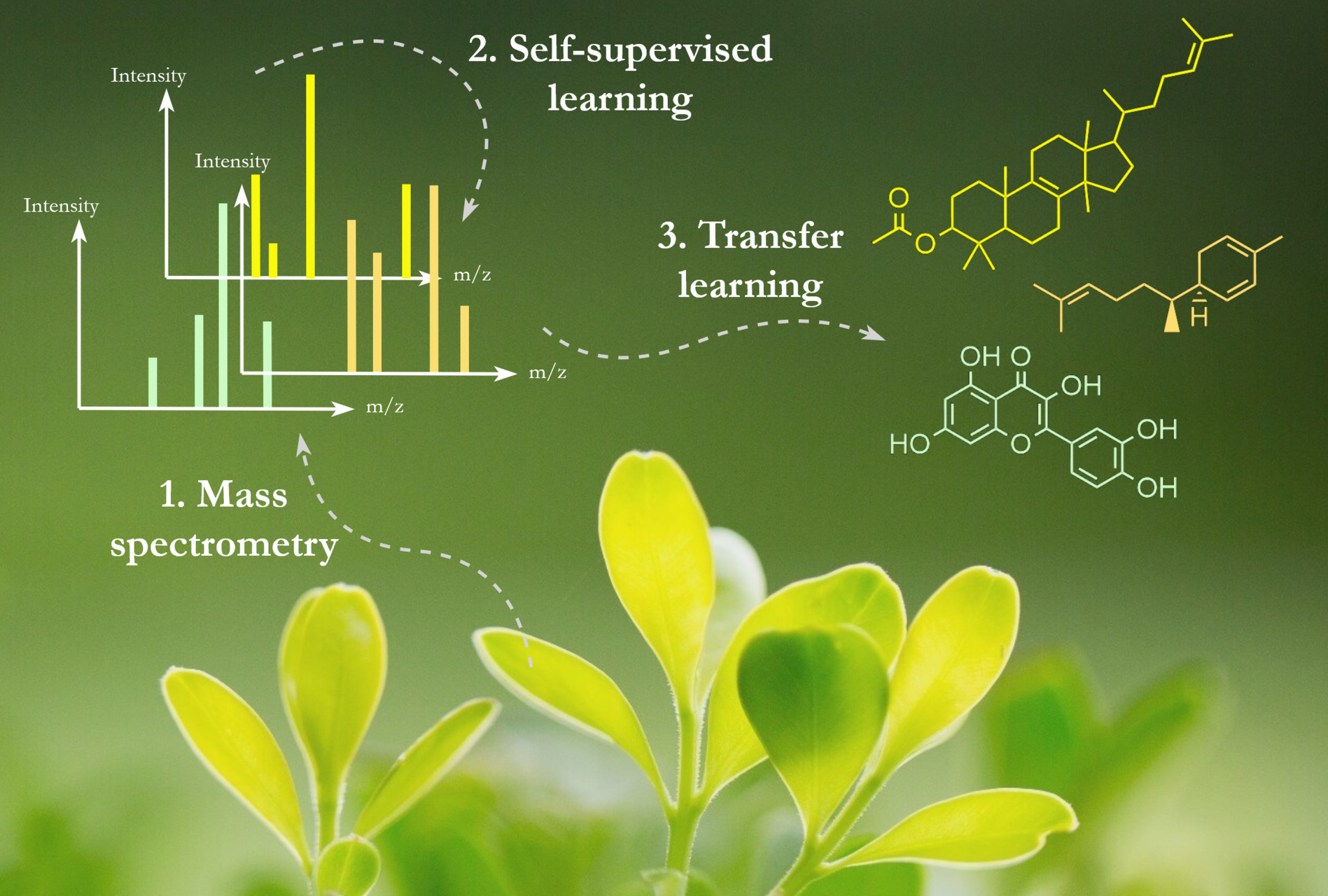
In spite of modern scientific advances, only a tiny fraction of plausible molecules have been discovered to date. Tandem mass spectrometry is a powerful technique enabling the identification of molecules present in biological samples. For each molecule, it measures a mass spectrum – a set of fragments of the molecule represented in terms of their masses. However, existing methods that attempt to arrange the fragments into the whole unknown molecule are extremely limited since they rely on narrow annotated libraries. In our research, we propose to break the limitation with self-supervised deep learning applied over hundreds of millions of unannotated mass spectra on the Karolina supercomputer. We train a large Transformer-based neural network to restore masked parts of spectra, which forces the network to learn the underlying structural properties of molecules without any annotations.
Structural dynamics-based design of compounds targeting Alzheimer’s disease
Call: 26th Open Access Grant Competition; OPEN-26-50
Researcher: Jan Mičan
Institution: Masaryk University
Field: Life Sciences
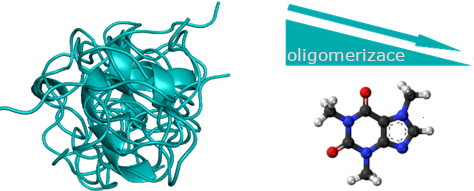
With aging population, Alzheimer’s disease surges like a modern epidemic against which no medicine exists. Jan Mičan, David Bednář, and Jiří Damborský, in collaboration with colleagues from the University of Cambridge, aim to design medicines targeting the motion of a small protein named amyloid beta 42.
They will use the computational time of 62 thousand nodehours supplied by IT4Innovations to simulate the motion of amyloid with candidate medicines. Using the VAMPNet approach, they will assess whether the amyloid is more resistant to forming toxic oligomers in the presence of the medicine.
This project aims to develop an effective and safe medicine for Alzheimer’s disease and accelerate the mapping of biomolecules' motion. This can help design medicines for other diseases, such as Parkinson’s disease and other amyloidoses, as well as knowledge of what the motion of molecules affects in our body.
CACHE challenge
Call: 25th Open Access Grant Competition; OPEN-25-38
Researcher: Pavlo Polishchuk
Institution: Palacky University Olomouc
Field: Biosciences
Searching for new drugs is very challenging due to the very large number of possible chemical compounds which may be investigated. Computational approaches may predict the most promising candidates to be tested and greatly speed up research. However, there are a lot of approaches and more advanced ones are very computationally demanding.
The CACHE challenge was organized by an international consortium of researchers from academia and industry to prospectively evaluate computational approaches and pipelines developing in leading research groups all over the world. The task is to discover new ligands of a specific domain of leucine-rich repeat kinase 2. This protein is linked to Parkinson's disease and the discovered ligands will offer new opportunities in anti-Parkinson research. All outputs will be contributed to the public domain to support open scientific researches.
Resistance and pathogenesis of extramedullary multiple myeloma
Call: 25th Open Access Grant Competition; OPEN-25-50
Researcher: David Žihala
Institution: University of Ostrava
Field: Biosciences
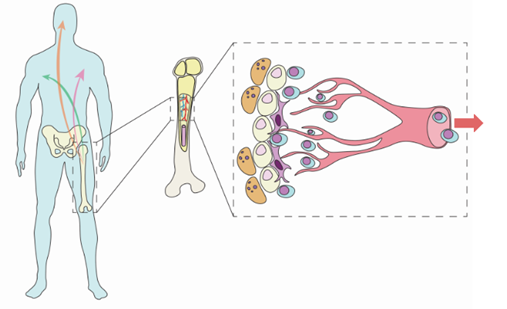
Extramedullary Disease (EMD) is an aggressive form of the second most common hematologic malignancy, multiple myeloma (MM). In standard MM, malignant plasma cells (PC; terminally differentiated B cells) proliferate clonally in the bone marrow, eventually leading to anaemia, myelosuppression, bone lesions, kidney failure, and other clinical aftereffects resulting from paraproteinemia.
EMD is characterized by malignant PCs independent of the bone marrow microenvironment. This acquired property allows tumor PCs to infiltrate other tissues and organs leading to a significantly worse prognosis. In our study, we use IT4Innovations computational resources combined with RNA/DNA data to study the molecular characteristics and tumor microenvironment of EMD, allowing us to better understand the pathology and resistance of this aggressive disease.
Peptide Killers of Bacteria
Call: 24th Open Access Grant Competition; OPEN-24-24, multiyear
Researcher: Robert Vácha
Institution: CEITEC
Field: Life Sciences
Infectious diseases are a major social and economic problem. Among them, infections associated with antibiotic-resistant bacteria are particularly important, not only prolonging and costing treatment, but above all leading to more deaths. It is estimated that more than 4.5 million people die each year from these resistant bacteria, and this number is rising steadily. In addition, bacteria resistant to all available antibiotics have emerged. This is why the WHO and the UN are calling for research into new drugs and the introduction of procedures to limit the spread of resistance. The aim of this project is to use computer simulations and computational approaches to design new peptides that could become such drugs by selectively targeting and disrupting the vital membranes of bacteria. At the same time, these peptides will be developed so that they do not disrupt human cell membranes due to their different lipid composition. The results of this research may also be used in the development of peptide sensors or biomarkers for different lipid compositions.
SKINNER
Call: special call within the 24th Open Access Grant Competition; OPEN-24-18
Researcher: Jan Hůla
Institution: Czech Technical University in Prague
Field: Life Sciences
Fascinating discoveries of the last decade showed that neural networks are able to learn a behavior that in many tasks produces much better performance than the algorithms designed by humans. Very often such neural networks are trained to mimic some observed phenomenon that is too complex for us to understand. One such example is recent success in language modeling where the neural network is trained to predict a missing word in a sentence. After the training, this network is able to generate whole paragraphs of text and engage in a believable dialog with a person. Our project aimed to test neural language models for modeling animal behavior because both tasks can be viewed as a sequence prediction. Concretely, we trained the network to predict the movement of joints in a 3D skeleton of a fly. The trained model can generate realistic-looking behavior and enable further analysis of behavioral patterns.
Interactions of surfactant-coated triglyceride nanodroplets with the tear film lipid layer in the context of dry eye disease
Call: 23rd Open Access Grant Competition; OPEN-23-48
Researcher: Maria Saija
Institution: the Czech Academy of Sciences
Field: Biosciences
Dry Eye Disease (DED) is a severe ocular disease that affects up to 30% of the global population.
One of the main challenges in its treatment is to stabilize the eye’s surface barrier, called the Tear Film Lipid Layer (TFLL). State-of-the-art ophthalmic formulations are based on eye drops containing lipid-based nano-emulsions. The project submitted to the IT4Innovations aimed at studying such emulsions in contact with the TFLL model using Molecular Dynamics simulations. In particular, we explored how such nanodroplets spontaneously transfer from an aqueous environment to TFLL, spread on its surface, and then incorporated into the tear film (Figure 1). We reckon that our project has a concrete impact on society as the results can help design new, better lipid nanodroplets for DED treatment.
GENOMIC INVESTIGATION OF ORGANELLAR EVOLUTION AND ENVIRONMENTAL ADAPTATION IN APICOMPLEXAN PARASITES
Call: 20th Open Access Grant Competition
Researcher: Dr Martin Kolísko
Institution: Institute of Parasitology of the Czech Academy of Sciences
Field: Life Sciences
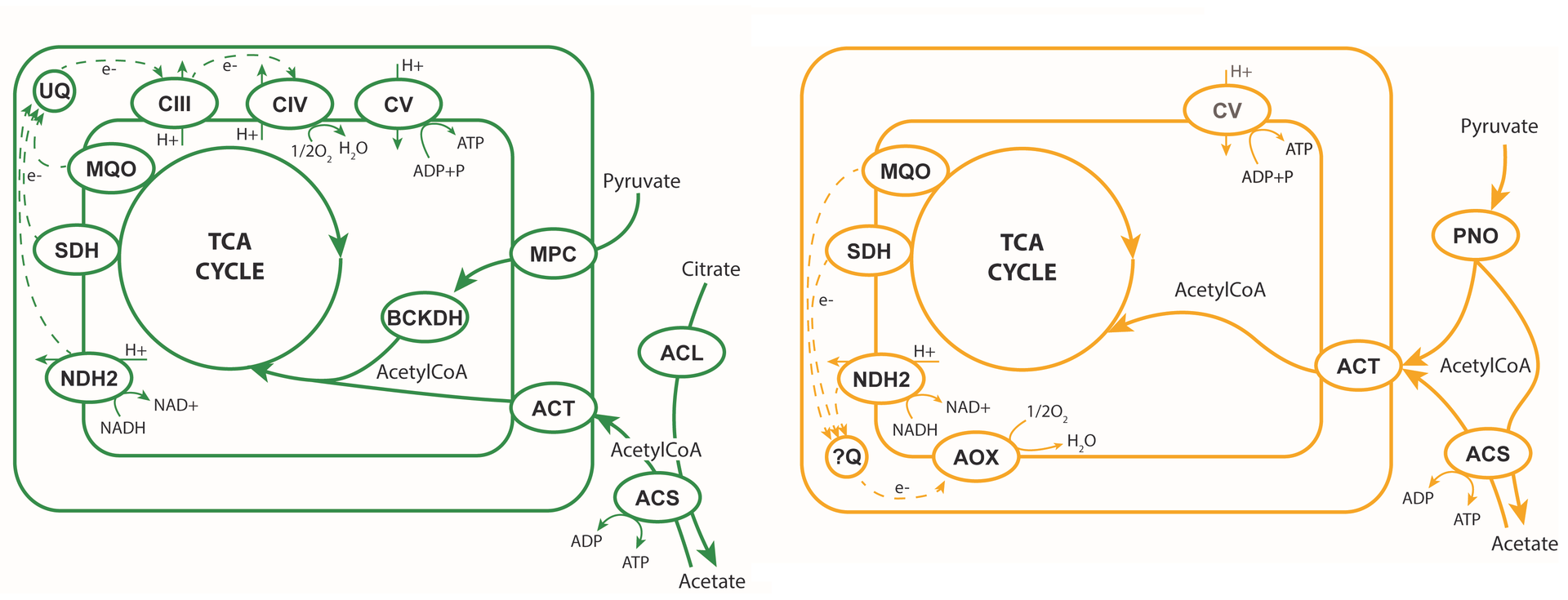
Apicomplexa are a group of intracellular parasites of animals and include, for example, agents of the serious human disease, malaria. Although much is known about the genetic makeup and organellar composition of core apicomplexan parasites, gregarines have been largely ignored despite being projected as one of the most species rich groups of eukaryotes. The project aims to characterize representative gregarine lineages from terrestrial and freshwater hosts. Gregarines cannot be cultured, so a method based on sequencing transcriptomes and genomes of individual cells will be used. The obtained data will be used only for phylogenomic analysis in combination with the recently published data on gregarines from marine hosts. This analysis will clarify the evolutionary position of gregarines in the Apicomplexa group, which has recently been challenged by contradictory results from two recently published studies. Robust phylogeny will then allow investigation of both the reductive evolution of organelles across the Apicomplexa group, and also genetic adaptation to different hosts, host environments, and intracellular parasitism occurring in other members of this Apicomplexa group.
SEARCH FOR NEW ANTICANCER COMPOUNDS AND INVESTIGATION THEIR MECHANISM OF ACTION
Call: 19th Open Access Grant Competition
Researcher: Dr Olena Mokshyna
Institution: Institute of Molecular and Translational Medicine, Palacky University in Olomouc
Field: Life Sciences
The development of novel anticancer agents is a long and complicated process, which involves an investigation of many potential targets for such therapies. In this project we are going to address several of such targets. Bystin is a compact protein promoting human cancer cell growth. Despite bystin being a promising target for anticancer drugs and drugs against Blackfan anemia, no site of binding was previously identified. Olena Mokshyna, who was awarded 510 000 core hours for her project, found that bystin has two primary shallow binding sites. Exploring the mechanisms of binding of promising drug-like compounds, she was able to establish stable binding poses for most of the ligands and distinguish two main groups of ligands with varying activity. Her project aims to further explore bystin dynamics using enhanced sampling methods and perform free energy calculations of ligand-protein systems. These methods are used with emphasis on metadynamics simulations, which would allow to explore the ligands’ mechanism of actions in silico. The second target protein is CYP2w1. The uniqueness of CYP2w1 consists in the fact that it is mostly expressed in tumor cells rather than in healthy tissues. This feature makes it a potential target for selective anticancer agents. There are currently a few compounds known, which not only selectively bind to the metabolic site of the protein but also turn to a cytotoxic compound, thus destroying a cancer cell, but not damaging the healthy tissues. Olena Mokshyna aims to perform virtual screening to select compounds with a similar mode of action for further experimental testing. The results of her project will facilitate development of anticancer drugs and medication to treat Diamond-Blackfan anemia.
QUANTUM MECHANICAL MODELING OF MISMATCHED DNA
Call: 19th Open Access Grant Competition
Researcher: Dr Petr Kulhanek
Institution: CEITEC, Masaryk University
Field: Life Sciences
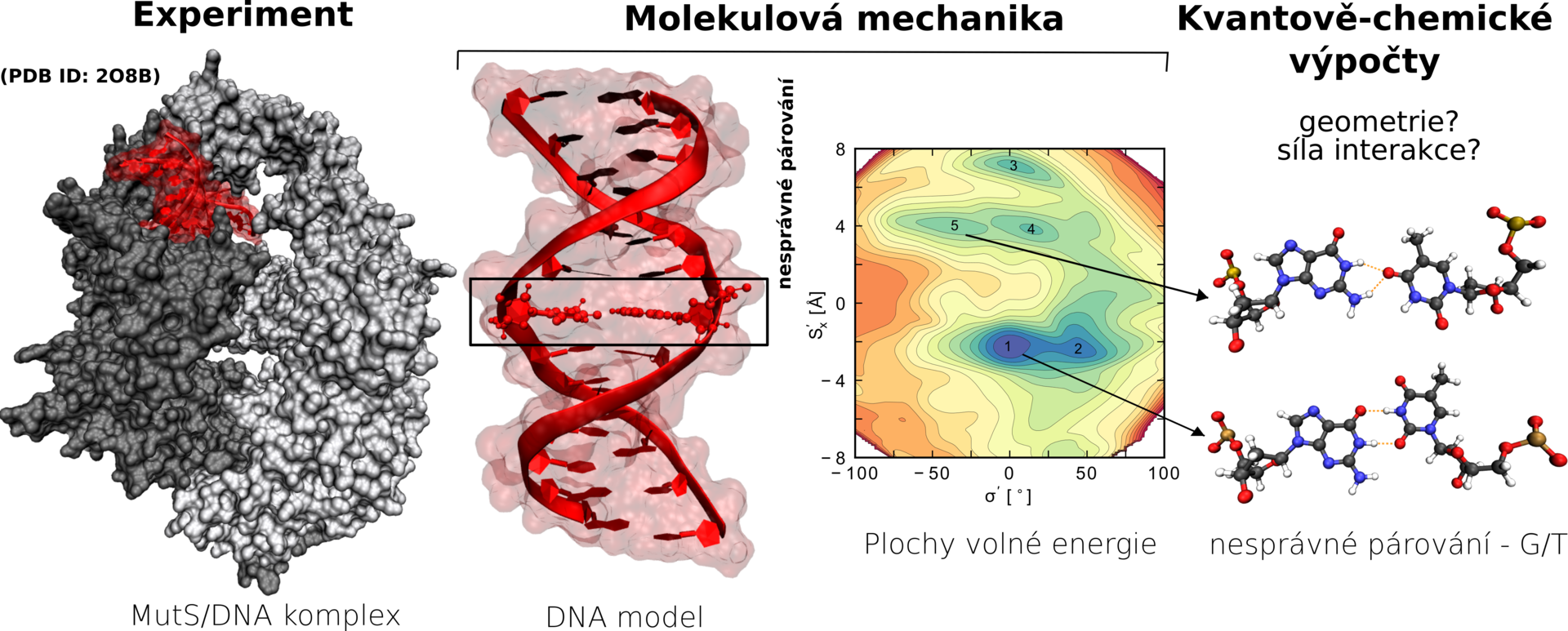
Deoxiribonucleic acid (DNA)double helix is composed of two complementary strands, which are held together by Watson-Crick base pairing. Base-pairing mismatches can result in the development of inherited genetic diseases, cancer, and aging. Therefore, organisms developed several ways how to detect and repair these base-pairing errors and thus keep the integrity of genetic information for next generations. One of them is the mismatch repair pathway (MMR), in which the MutS enzyme detects mismatches and once found, it triggers a cascade of processes leading towards their repair. Petr Kulhanek and his research team tried to decipher how MutS can effectively detect base-pairing mismatches. In order to do so, they applied molecular mechanics and dynamics methods based on simplified physical description. This, at the cost of lower accuracy, makes it possible to study large biomolecular systems. Petr Kulhánek will use the awarded 532 000 core hours for quantum-chemical calculations to validate accuracy of the results achieved in previous studies. In this way, he will not only obtain information on the quality of the simplified physical description but also more detailed information about individual interactions in non-complementary base pairing and their relevance to MutS enzyme recognition. The obtained data is important for future rational design of chemical substances suitable in anti-cancer therapy, which will target damaged DNA.
PROTEIN AFFINITY AND SELECTIVITY TO CELLULAR MEmbranes
Call: 18th Open Access Grant Competition
Researcher: Dr Robert Vácha
Instituce: CEITEC
Field: Life Sciences
For the first phase of his research focused on protein affinity and selectivity of cellular membranes, Robert Vácha was awarded almost 2.9 million core hours. Spatial and temporal organisation of proteins in the cell is a crucial aspect for understanding the complex processes in living cells. Peripheral proteins organised at membranes of specific organelles to correctly perform their functions are important elements. However, the relationship between the protein sequence and its membrane is not yet known. The aim of the proposed project is to identify, quantify, and explain protein affinity for membranes with specific lipid composition. The team led by Robert Vácha aims at developing a computational method to determine the finding free energy of proteins and their mutants to membranes with specific lipid composition. Application of this method with the aid of the IT4Innovations computational resources will provide molecular understanding allowing the preferred localization of proteins in cells to be determined and as such it can be used in development of new protein biomarkers, sensors, and drugs.
PHOTOACOUSTIC TOMOGRAPHY OF THE BREAST
Call: 17th Open Access Grant Competition
Researcher: Dr Jiří Jaroš
Institution: Brno University of Technology
Field: Life Sciences
Jiří Jaroš from BUT was awarded more than 300,000 core hours for validation of the developed photoacoustic tomography (PAT) software on a set of breast phantoms and optimisation for speed and accuracy. The goal is to validate the generated PAT image under noisy conditions and the presence of moving artifacts, inhomogeneous lighting, limited sensor bandwidth, and variability between ultrasound sensors caused by a given production technology. This data will be used for fine tuning of the PAT software before being used with a set of 20 patients. The images generated using photoacoustic tomography, x-ray imaging, and computed tomography will then be passed on to clinical doctors for evaluation. The results of this study shall lead to development of new screening and diagnostics methods in breast mammography. The tissue is exposed to an infrared beam with a nanosecond pulse with energy being absorbed by tumour blood vessels. Then, thermo-elastic expansion occurs inside the tumour (the tumour trembles). Radiation changes into heat in the form of generating ultrasound pulses by density change. Ultrasound propagates out of the tissue and is recorded on the surface of ultrasound detectors. The goal of these simulations performed within the project is to use the recorded signal to reconstruct the place the sound comes from, and its quantitative qualities (position of blood vessels, their size, amount of oxygenated blood, etc.).
ALZHEIMER‘S LIPIDS III
Call: 17th Open Access Grant Competition
Researcher: Dr Michael Owen
Institution: CEITEC
Field: Life Sciences
Alzheimer‘s disease is a chronic, progressive disorder of the nervous system, which causes degenerative death of neurons associated with characteristic histopathologic changes. This disease is diagnosed in 1 of 8 people aged over 65, which makes it the most common cause of dementia in middle-aged to upper-aged people. It is expected that by the year 2030, 14 million people will have suffered from this disease. Michael Owen from CEITEC was awarded over 1 million core hours for his first study, focused on the lipids associated with Alzheimer‘s disease. He will use the computational resources to shed light on the aggregation mechanism in amyloid-β (Aβ) peptide, which is a characteristic feature observed in Alzheimer‘s development and progression. Aggregation will be studied in the presence of gangliosides, which may affect Aβ peptide aggregation and have an undisputed role in the development and regeneration of the brain and progression of Alzheimer‘s disease. Apart from gaining atomic insight into the role of gangliosides in Alzheimer‘s disease, this project will also be beneficial for the research of other neurodegenerative diseases such as Parkinson‘s and Huntington‘s diseases.
VIRTUAL SCREENING OF HUMAN AND PLANT HORMONES
Call: 16th Open Access Grant Competition
Researcher: Dr Václav Bazgier
Institution: Palacký University in Olomouc
Field: Life Sciences
Virtual screening employs supercomputers to discover potentially new chemical compounds, which is a cheaper and less time-consuming approach than their laboratory testing. The computer selects the best performing candidates from a large library of chemical compounds, which are then experimentally tested. Václav Bazgier from Palacký University in Olomouc was awarded almost half a million core hours for his project titled Virtual screening of human and plant hormones. These hormones play a crucial role in human, animal, and plant life, and are responsible for a number of processes of biological interest. The allocated computational resources will be used in the design of new compounds – hormone-based drugs and fertilizers – by means of molecular docking using data from different databases such as DrugBank and the Human Metabolome Database.
MECHANISM OF GENOME RELEASE OF NON-ENVELOPED VIRUSES
Call: 16th Open Access Grant Competition
Researcher: Lukáš Sukeník
Institution: CEITEC, Masaryk University
Field: Life Sciences
Many picornaviruses are human pathogens that cause diseases varying from the common cold to life-threatening encephalitis. Currently, there is no picornavirus antiviral drug approved for humans. Lukáš Sukeník from CEITEC and Masaryk University was awarded more than 4 million core hours to study the mechanism of picornavirus genome release. A cell can be infected once the picornavirus genome is released. These non-enveloped viruses need to transport their genetic material from the protective protein shell (capsid) to host cell cytoplasm. Using the supercomputer and molecular dynamics simulation, Sukeník will study the affects of the capsid properties on genome release. The knowledge obtained will be used for the development of new antiviral therapeutics.
MACHINE LEARNING IN BIOMETRICS AND BIOMEDICINE
Call: 15th Open Access Grant Competition
Researcher: Jan Tinka
Institution: Brno University of Technology
Field: Life Sciences
The computational resources amounting to almost 1 million core hours will be used by scientists from Brno University of Technology for development of automated detection system for diabetic retinopathy, and for removing the effects of skin diseases for fingerprint recognition. Retinopathy often refers to a retinal vascular disease, or damage to the retina caused by abnormal blood sugar. A higher risk of development of various forms of this disease is present in diabetes patients. The objective of the project of Jan Tinka and his team is to develop a detection system using machine learning algorithms, the use of which will be user-friendly for eye specialists as well as patients. In cooperation with dermatologists, Jan Tinka is also developing a system for detection, localization, and recognition of fingerprint damage.
COMPUTATIONAL CHARACTERIZATION OF SELECTED PROTEINS ASSOCIATION FREE ENERGIES II
Call: 15th Open Access Grant Competition
Researcher: Dr Jozef Hritz
Institution: Masaryk University
Field: Life Sciences
Already the seventh project of Dr Hritz from Masaryk University was awarded computational resources of IT4Innovations. He uses supercomputers, for example, for his research of the 14-3-3 protein complexes and tyrosine hydroxylase (TH). His project submitted within the 15th Open Access Grant Competition was awarded more than 1.5 million core hours. The research objective is to reveal structural and free energy changes, which are essential for protein complexes’ formation. Any disruption of the network of interactions underlying the formation of protein−protein complexes may lead to a number of pathologies. His research group will also focus on TH, one of the key enzymes operative in the human brain. The TH/14-3-3 protein complex regulates the level of dopamine, an organic chemical which plays an important role as a neurotransmitter, and of which deficiencies are heavily Conserved association pathway of phosphorylated partners to the primary binding location (IS1) of the 14-3-3 protein is shown in green. The image is taken from the publication NAGY, G., C. OOSTENBRINK, J. HRITZ a Y. Koby LEVY: Exploring the Binding Pathways of the 14-3-3ζ protein: Structural and Free-energy Profiles Revealed by Hamiltonian Replica Exchange Molecular Dynamics with Distancefield Distance Restraints. PLOS ONE. 2017, 12(7). DOI: 10.1371/journal.pone.0180633. implicated in the onset of Parkinson’s disease. By combining state-of-the-art computer simulation and contemporary experimental techniques (e.g., nuclear magnetic resonance and cryoelectron microscopy), better understanding of the dynamical properties and thermodynamics of protein association will be possible. Using strengthened sampling computational methods, Dr Hritz’s research team has, for example, already discovered that the 14-3-3 protein must adopt a transitional conformation state not known up till now. Moreover, they discovered a conserved associated pathway serving client proteins to reach their final binding conformation once they are phosphorylated. These findings can be useful in explaining the effects of mutation along this association pathway as well as in its use as the target for designed drugs modulating this group of the 14-3-3 protein complexes.
HYALURONAN STRUCTURE, INTER-MOLECULAR INTERACTIONS AND INTERACTIONS WITH PROTEIN RECEPTORS
Call: 14th Open Access Grant Competition
Researcher: Dr Marek Ingr
Institution: Tomáš Baťa University in Zlín
Field: Life Sciences
Hyaluronic acid is a natural polysaccharide present, for example, in connective tissues and synovial fluid. It performs a large number of biological functions and is used not only in cosmetics but also in the healthcare sector in osteoarthritis treatment and wound and burn care. Hyaluronic acid reacts with protein receptors and mediates cellular signalling amongst other functions. Therefore, it is assumed that it also plays its part in the development of various diseases, including cancer. Research of hyaluronic acid and the mechanism of its molecular interactions with protein receptors is also carried out by Marek Ingr from Tomáš Baťa University in Zlín, who was awarded computational resources in our 12th as well as 14th Open Access Grant Competitions. He uses a supercomputer to perform molecular dynamics simulations with the aim to detect, for example, the key hyaluronan-protein interactions. Building on these findings, new drugs and cosmetic products may possibly be designed.
REACTION MECHANISMS OF DINUCLEAR OPEN-SHELL METALLOENZYMES
Call: 13th Open Access Grant Competition
Researcher: Dr Lubomír Rulíšek
Institution: Czech Academy of Sciences
Field: Life Sciences
Metalloproteins play an important role in nature as catalysts of biochemical reactions which would not occur in the absence of metal ions. These reactions include nearly all oxidation-reduction processes, spin-forbidden processes, or processes, during which fission of very stable chemical bonds (C-H bonds, triple or double bonds in N2 or O2 molecules) occur. These fundamental biological processes include, for example, photosynthesis and cellular respiration. To understand the function and structure of metalloproteins, not only experiments (e.g. x-ray crystallography, spectroscopy, and electro-chemical measurements) but also computational methods of theoretical chemistry, which can provide insights into the structure and energetic properties of metalloproteins, are important. The project led by Dr Lubomír Rulíšek from the Czech Academy of Sciences focuses on the research of three selected metalloproteins with polynuclear cores (hence more metal ions at enzyme active sites), which play an important role not only in nature but also as potential industrial catalysts. His project was awarded over 3 million core hours. The allocated computational resources will be used for comparing experimental results with results obtained from quantum-mechanical modelling (using the Turbomole, MOLCAS, Amber, ComQum, and ORZ programs) with the objective to obtain a description of the catalytic cycles of the studied metalloenzymes. The research results have the potential to be used for biomimetic (inspired by nature) designs for catalytic cycles finding their potential area of application in the chemical industry.
PREDICTSNP-ONCO: STRUCTURAL BIOINFORMATICS ANALYSIS FOR PERSONALIZED PEDIATRIC ONCOLOGY
Call: 13th Open Access Grant Competition
Researcher: Dr Gaspar Pinto and Jan Štourač
Institution: Masaryk University
Field: Life Sciences
The research teams of Prof. Jiří Damborský and David Bednář from Masaryk University in Brno, Prof. Jaroslav Štěrba from University Hospital Brno - Children‘s Hospital, and Doc. Ondřej Slabý from CEITEC are involved in development of the new PredictSNP-Onco computational tool designated for personalized pediatric oncology. The new tool aims at making it faster for doctors to design the most suitable treatment for each individual patient, whose treatment so far based on standard methods has failed, or where the probability a of successful cure by standard methods is very low. Cancer cell formation may be caused by one single mutation. Therefore, it is vitally important to assess such mutations as fast as possible, and consider treatment by all available drugs (inhibitors) which have been certified by the European Medicine Agency (EMA), the State Institute for Drug Control (SIDC), or by the U.S. Food and Drug Administration (FDA). The computational resources of almost 800 thousand core hours will be used by the researchers to assess all possible protein mutations which lead to cancer development, and for analyses of inhibitors using the computational molecular docking method. Using information from four world-wide databases of mutations along with the computed results, the researchers will help design new possibilities for personalized/precise treatment for various types of cancer. Doctors thus obtain information in a shorter time, which enables them to speed up the design of appropriate an treatment for each individual patient in good time.
INTERACTIONS OF DRUG MOLECULES WITH MIMICS OF HUMAN TEAR FILM
Call: 13th Open Access Grant Competition
Researcher: Dr Lukasz Cwiklik
Institution: Czech Academy of Sciences
Field: Life Sciences
The tear film protects the cornea of the human eye against water evaporation. It nourishes the cornea surface, and it serves as the first line of protection against eye surface infection. It is produced by spreading tears all over the eye surface by a blink of an eye. Its thickness changes during eye blinking. Essentially, it consists of a lipid and a water layer. Disorders in the lipid layer lead to dry eye syndrome, which is treated with eye drops. The researchers from the J. Heyrovský Institute of Physical Chemistry CAS are the only ones worldwide to study the effectiveness of eye drops at the molecular level. They are seeking ways to transport the required substances through the lipid layer and cooperate with pharmaceutical companies in tear film research. Microscopic research of the lipid layer will be supplemented with computer simulations using the Salomon supercomputer by Lukasz Cwiklik. His project was awarded more than 1.5 million core hours in our 13th Open Access Grant Competition. The allocated computational resources will be used for research of selected lipophilic drugs, in particular the way the drugs permeate through the lipid layer to the water layer. Experimental (use of biomimetic chip, the construction of which was awarded the prestigious Neuron Impulse grant) and computational results of the research will enhance our knowledge of the interaction of drugs with the human tear film, and eventually the design of a new generation of eye drops. For the website of Dr Cwiklik’s research, see: http://cwiklik.net.
STRUCTURAL STUDIES OF HUMAN AND ANIMAL VIRUSES
Call: 12th Open Access Grant Competition
Researcher: Dr Pavel Plevka
Institution: CEITEC MU
Field: Life Sciences
The project of Dr. Pavel Plevka from CEITEC at Masaryk University was awarded 2,213,000 core hours for his research of picornaviruses, flaviviruses, and bacteriophages. Our supercomputers and the allocated computational resources will be used for processing and analysis of micro images created by state-of-the-art electron microscopes. Picornaviruses cause not only common cold but also serious diseases such as encephalitis and respiratory inflammation. Scientists determine the structure of virus particles (virions), by means of which the virus spreads from one cell to another, and describe viral replication in infected cells. Flaviviruses, including Zika and encephalitis viruses, cause potentially fatal neurological diseases. Scientists will focus on an encephalitis virus causing hundreds of potentially fatal infections in the Czech Republic every year. The results of the project shall provide scientists with a detailed description of the viral replication mechanism.
STRUCTURAL CHARACTERIZATION OF INTRINSICALLY DISORDERED PROTEINS
Call: 12th Open Access Grant Competition
Researcher: Prof. Lukáš Žídek
Institution: Masaryk University
Field: Life Sciences
Intrinsically disordered proteins (IDPs) are macromolecules lacking a stable and well defined tertiary structure. They have no stable structure and hence no thermodynamic minimum determining their function. During the course of the last decade, they have attracted wide attention due to their important role in a vast number of cellular processes. They include, for example, transcription of genetic information as well as their potential connection with neurodegenerative diseases. Recent research findings have shown that the main role in the protein function is not in their structure but their dynamic behaviour. The project of prof. Lukáš Žídek from Masaryk University, which was awarded 1,480,000 core hours, is aimed at a more detailed study of the conformational behaviour of selected IDPs using a combination of state-of-the-art extensive computer simulations with their own prediction codes and advanced experimental methods (e.g., nuclear magnetic resonance spectroscopy, or small angle X-ray scattering.
PROTON ACCELERATION VIA LASER INTERACTION WITH PLASMA MICRO-BUNCHES PRODUCED BY CRYOGENIC HYDROGEN RIBBON
Call: 12th Open Access Grant Competition
Researcher: Martin Matys
Institution: Czech Technical University in Prague
Field: Life Sciences
Being also involved as researchers in the ELI Beamlines project, Ing. Martin Matys and Dr. Jan Pšikal from the Czech Technical University in Prague were awarded 800,000 core hours for their project focusing on ion accelerator development. In particular, they are involved in research of proton acceleration induced by high power laser impulse interaction with a cryogenic hydrogen ribbon. Laser based ion accelerators have the potential to replace the extremely expensive conventional accelerators in the future, thereby, for example, lowering the costs of proton therapy for treatment of oncological diseases as well as the production costs of medical isotopes for positron emission tomography. Scientists are particularly interested in the interaction when a laser pulse burns through the target and then interacts with the remaining plasma micro-bunches of much lower density than the initial target. Such a mechanism is capable of accelerating protons to energy ranges of hundreds of millions of electron volts. The project objective is deeper study of this mechanism using numerical three-dimensional simulations, which is significantly cheaper in comparison to real experiments.
FIJI BIOIMAGE INFORMATICS ON HPC - “PATH TO EXASCALE”
Call: 12th Open Access Grant Competition
Researcher: Dr Michal Krumnikl
Institution: IT4Innovations
Field: Life Sciences
The IT4Innovations National Supercomputing Center – path to exascale project, which supports the research in the area of biological image analysis using HPC, allows IT4Innovations to participate in the research of large bioimage dataset processing using high performance computing (HPC) systems. This research is focused on parallelization of key steps in, for example, light sheet microscopy data processing. Light sheet microscopy has become popular for scanning living cells and organisms for its speed and low photo toxicity, which allows complex living systems such as embryos to be microscopically scanned three-dimensionally with high resolution and for their entire development period. The main objective of the project is to extend the options of the Fiji platform, which is used by tens of thousands of users worldwide for the processing of large image datasets. The development team led by Dr. Krumnikl in collaboration with Dr. Pavel Tomančák from Max Planck Institute in Dresden (Germany) will modify each data analysis method for seamless running on HPC systems. Development and deployment of the Fiji platform on HPC systems shall allow its users to fully exploit its potential on large bioimage datasets.
DEEP LEARNING FOR NOVEL DRUG DISCOVERY
Call: 11th Open Access Grant Competition
Researcher: Vojtěch Cima
Institution: IT4Innovations
Field: Life Sciences
The Deep learning for Novel Drug Discovery project of Ing. Vojtěch Cima has been awarded 400,000 core hours. The allocated computational resources will be used for deep learning in predicting the effects of potential drugs and their possible toxic side effects. Using prediction algorithms, novel drug discovery and the related costs can simultaneously be accelerated and reduced respectively. This research is carried out as part of the ExCAPE project, the objective of which is to develop algorithms for solving complex pharmacological problems.
RELATIVE STABILITIES OF MISMATCHES IN NUCLEIC ACIDS
Call: 11th Open Access Grant Competition
Researcher: Dr Petr Kulhánek
Institution: CEITEC, Masaryk University
Field: Life Sciences
The research team led by Dr. Kamila Réblová and Dr. Petr Kulhánek from the Central European Institute of Technology - Masaryk University (CEITEC MU) has been awarded 634,000 core hours for their research into the relative stability of base pairing in deoxyribonucleic acids (DNA). Chains of the double helix structure of DNA carry genetic information, the integration of which is secured by Watson-Crick complementary pairing. During the process of DNA replication, which occurs when cells divide, this complementarity is used in creating two identical copies of DNA. However, during the replication process, errors such as mismatched base pairs can occur. This is then recognized by various reparation mechanisms. One of them is mismatch repair (MMR), with the MutS enzyme being the active component in mismatch recognition. When such mismatch is detected, this enzyme activates a cascade of processes leading to its repair. The allocated computational resources of IT4Innovations supercomputers will allow scientists to perform molecular simulations of short molecules of DNA and focus on describing the stability of all possible combinations of bases containing both the correct Watson-Crick pair and all other combinations. It is believed that this stability can be one of the many factors affecting the effectivity of the MMR mechanism in detecting errors. The information obtained may thus be important for understanding the development of genetically determined diseases or the formation of cancerous growths.
EXPERIMENTAL VERIFICATION OF COMPUTER SIMULATION OF NON-LINEAR ULTRASOUND PROPAGATION THROUGH BIOLOGICAL TISSUES
Call: 10th Open Access Grant Competition
Researcher: Dr Jiří Jaroš
Institution: Brno University of Technology
Field: Life Sciences
The research team of Dr. Jiří Jaroš has been awarded 2,678,000 core hours for their research in the field of computer simulations of ultrasound propagation in biological tissues. The researchers focus on targeted ultrasound, which is applied in the treatment of non-invasive cancer and other diseases. The targeted ultrasound is based on the principle of focusing high-power ultrasound beams through biological tissues. Surgeons are thus able to remove a tumour from the body of their patients using a non-invasive procedure. The results of the ultrasound surgery, however, are influenced by many factors, such as presence of bones, large blood vessels, and fat surrounding organs. These factors lead to attenuation, scattering, and reflection of the ultrasound wave, which then does not have enough energy in the required area. Therefore, the awarded allocation will be used by the research team from Brno University of Technology for evaluating the accuracy and optimization of the models of ultrasound propagation in biological tissues.
THE ROLE OF HYBRIDIZATION IN TRIGGERING ASEXUAL REPRODUCTION IN FISH
Call: 9th Open Access Grant Competition
Researcher: Karel Jank
Institution: University of Ostrava
Field: Life Sciences
The researchers from the University of Ostrava will deal with a very interesting topic – asexual reproduction in fish. They will focus on the fish family Cobitidae, which are widespread throughout Europe. You may know some species of this family occurring throughout the Czech Republic: Weatherfish (Misgurnus fossilis) and Spined Loach (Cobitis taenia). The reproductive abilities of this fish can be repeatedly disrupted by interspecies breeding. Interspecies breeding can lead to emergence of asexual fish individuals: both infertile males and fertile females, which do not reproduce sexually. In contrast, they reproduce clonally. All the asexual females need to reproduce is the presence of the sperm cell (male reproductive cell) to stimulate the egg cell development without the fertilization process. The offspring are all females, the clones of their mother. Why are clonally reproducing individuals produced during interspecies breeding only? Does the emergence of such asexual fish individuals represent a natural evolutionary step in the formation of new species? Using the IT4Innovations supercomputers, the answers to these questions will be sought by the research team led by Dr. Karel Janko within the project entitled “The role of hybridization in triggering asexual reproduction in fish”.
PROTEIN-PROTEIN INTERACTIONS IMPORTANT IN NEURODEGENERATIVE DISEASES
Call: 9th Open Access Grant Competition
Researcher: Dr Jozef Hritz
Institution: Masaryk University
Field: Life Sciences
The research team led by Dr. Jozef Hritz will use the IT4Innovations supercomputers for the research of the 14-3-3 protein complexes, which are associated with oncological and neurodegenerative diseases, such as Alzheimer's and Parkinson's disease. On the atomic level, the static molecular structure of these proteins has already been studied using experimental techniques such as X-ray crystallography and nuclear magnetic resonance. However, their dynamics have not been thoroughly studied yet. Study of the dynamical properties is essential for understanding the origin of these protein complexes because this knowledge allows target action to be taken in order to prevent the processes causing the development and progression of Alzheimer’s and Parkinson’s disease. The researchers from Masaryk University would like to describe these changes and thus contribute to the understanding of both neurodegenerative diseases.
DETECTION AND EVALUATION OF ORBITAL FLOOR FRACTURES USING HPC RESOURCES
Call: 9th Open Access Grant Competition
Researcher: Dr Petr Strakoš
Institution: IT4Innovations
Field: Life Sciences
The research team at IT4Innovations implements state-of-the- -art approaches to information technologies in medical diagnostic methods. They are focused on precise detection and measurement of orbital floor fractures from computer tomography (CT) scans in cooperation with the doctors from the University Hospital Ostrava. The objective of this project is to develop new, and improve existing, methods for CT scan analysis using image filtering and segmentation, and developing parallel algorithms for 3D model reconstruction. The algorithms will be applied to analysis of post-traumatic treatments of patients with eye injuries.

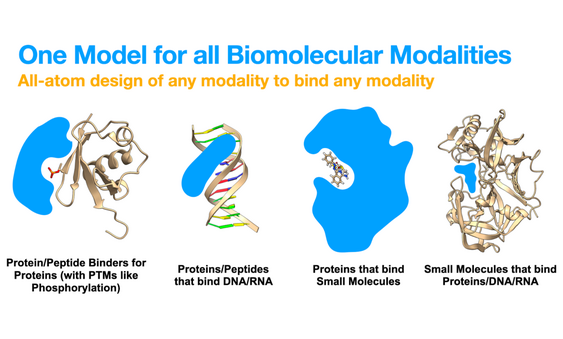
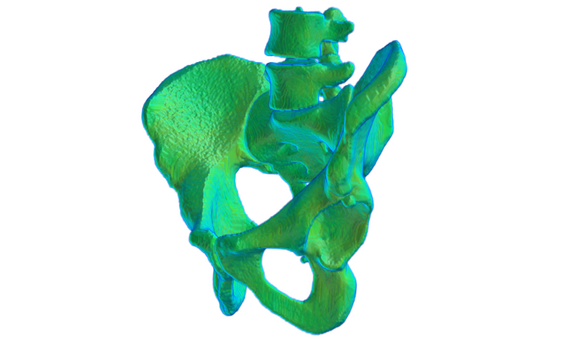
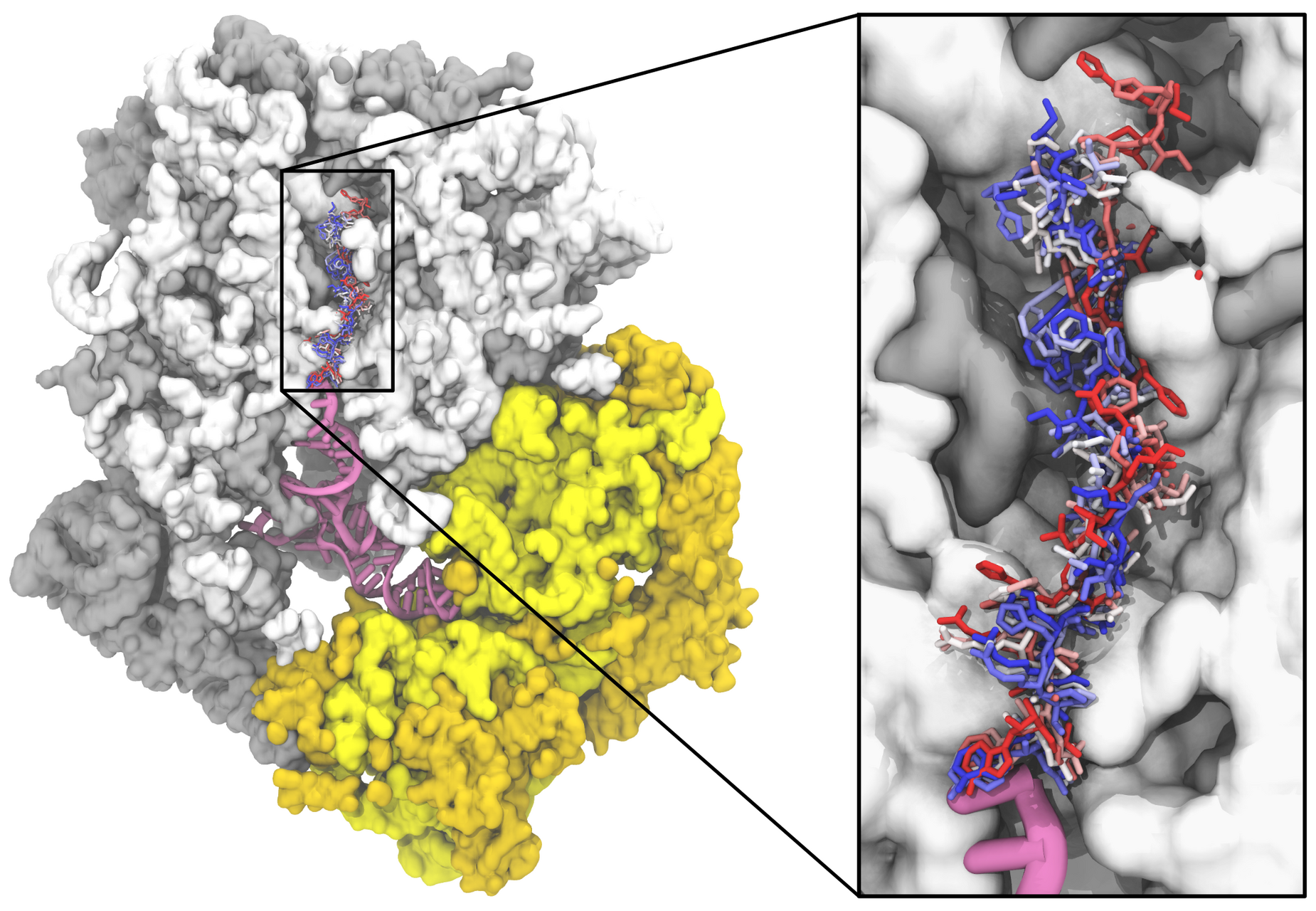
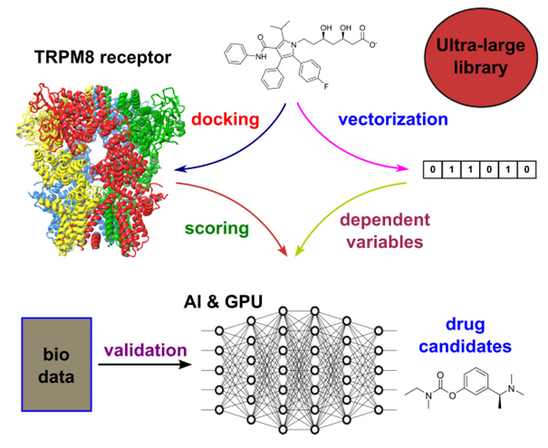
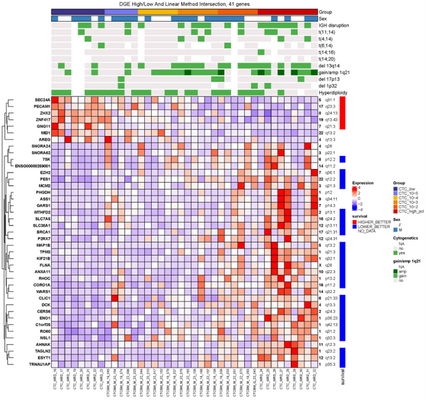
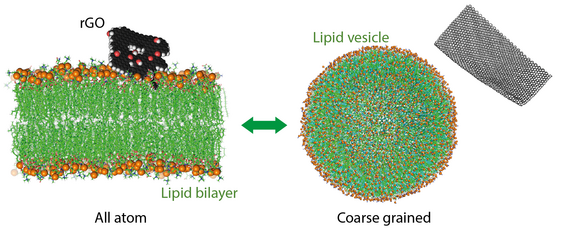



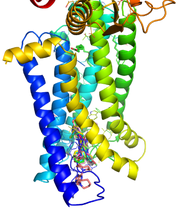.png)
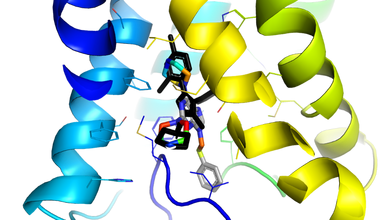.png)
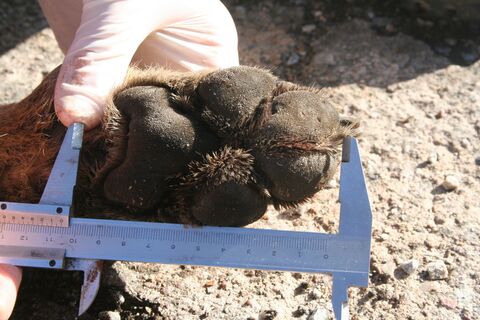
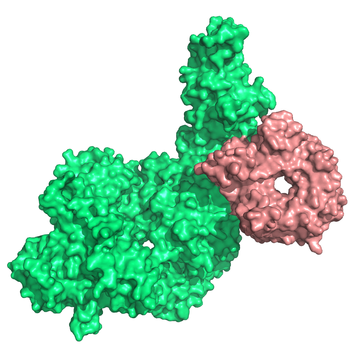

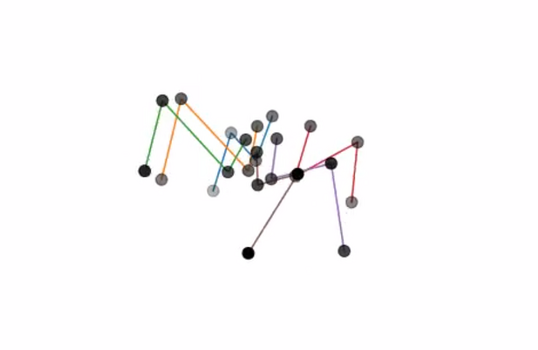
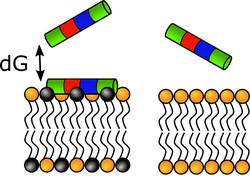
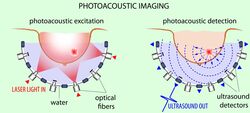
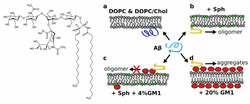
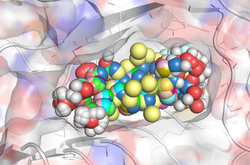
.png)
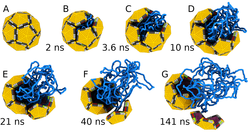
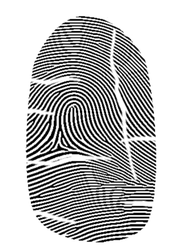
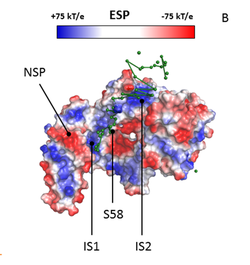
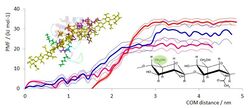
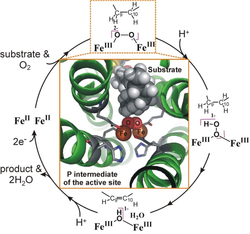
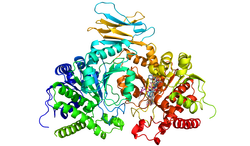.png)
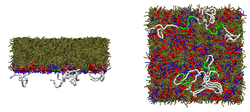
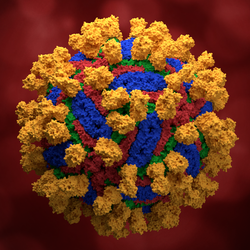%20Rekonstrukce%20viru%20kl%C3%AD%C5%A1%C5%A5ov%C3%A9%20encefalitidy%20pomoc%C3%AD%20kryoelektronov%C3%A9%20mikroskopie.png)
